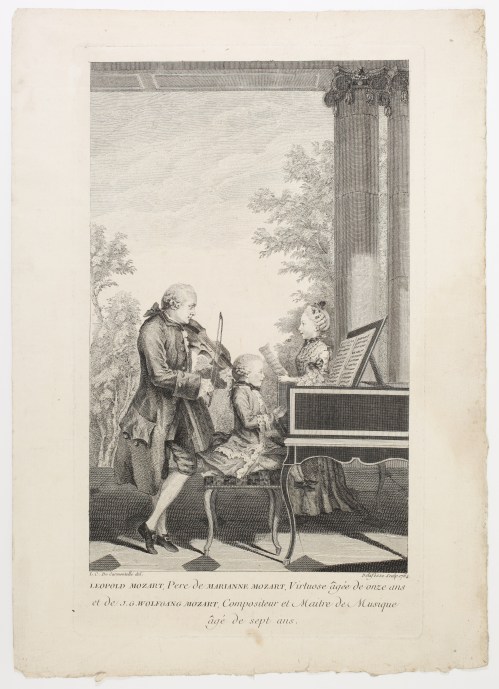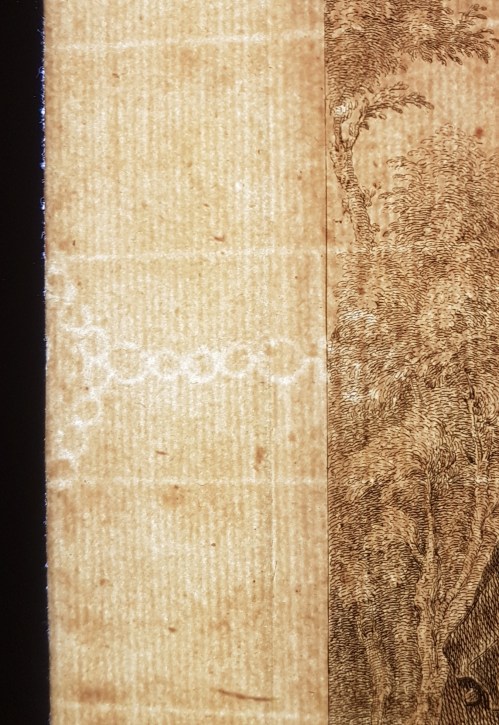Jean-Baptiste Joseph DELAFOSSE: LEOPOLD MOZART, Pere de MARIANNE MOZART, Virtuose âgée de onze ans et de J. G. WOLFGANG MOZART, Compositeur et Maitre de Musique âgé de sept ans -
SOLD
[LEOPOLD MOZART, Father of MARIANNE MOZART, Virtuoso aged eleven and of J. G. WOLFGANG MOZART, Composer and Master of Music aged seven]
Etching and engraving after Louis Carrogis de Carmontelle (1717 - 1806), 373 x 221 mm. IFF 52, 2nd state (of 2). Portalis and Beraldi no. 20.
Impression of the 2nd state (of 2) with letter.
Very fine impression printed on watermarked laid paper (part of a necklace?). Generally in very fine condition. A small foxmark in the bottom with a tiny pinhole associated, small marginal stains, a light spot on the right edge of the sheet, a tiny 5 mm tear on the upper edge. Good margins all around the platemark (sheet: 420 x 300 mm).
Scarce.
Leopold Mozart visited Paris in 1763, during a tour of Europe that he undertook with his two young children. The Mozart family was immediately introduced at Versailles thanks to Baron Grimm. It is very tempting to imagine Louis Carrogis de Carmontelle making the portrait of Leopold and his two child prodigies in one of the ‘salons’ of the court at Versailles, or in Saint-Cloud, or perhaps at the home of the Countess of Tessé. Florence Gétreau however remarks that Siegbert Rampe, “who, a decade or so ago, authored two chapters making for essential reading and focusing on instruments and portraits of Mozart at the keyboard, in his seminal book about Mozart’s keyboard music” suggests that “this family portrait was probably made at the home of Baron Grimm. According to Rampe, the harpsichord in the picture looks like it might have two keyboards, considering its height compared to Mozart’s cheek: it might be the harpsichord belonging to the Baron, and which is known to have been made by Antoine Vater in Paris in 1755, in black lacquer with golden inlays, a common feature with French harpsichord makers.” (Florence Gétreau, 2007, p. 3 and 9, our translation)
Portraits by Carmontelle depicted men and women of all social classes, were already well known and appreciated by contemporaries. Baron Grimm noted in 1763:
“For several years now Carmontelle has been working on a collection of portraits in pencil, with colour washes. He has superior talent for capturing the mien, the deportment and the countenance of the people he paints, his portraits are made with infinite ease, grace and wit. It has often happened to me that I recognised in real life people I had only ever seen in his books.” (Friedrich Melchior, baron Grimm, La Correspondance littéraire, 1st January – 15 June 1763, our translation).
The Mozart family portrait is one of Carmontelle’s most famous, on a par with the portraits he made of Jean-Philippe Rameau and Benjamin Franklin. Carmontelle’s watercolour is in the Musée Condé in Chantilly (Gruyer no. 418). The etching by Jean-Baptiste Joseph Delafosse reproduces it with the same orientation. From Leopold Mozart’s letters we know he was aware of the portrait and he used Delafosse’s print when taking care of the promotion of his children in Europe:
« M. de Mechel, a copper engraver, is working in haste in order to engrave our portraits that M. de Carmontelle, a connoisseur, painted very well: Wolfgang is playing the keyboard, I am standing behind his chair playing the violon and our Nannerl is leaning with one arm on the harpsichord; in the other hand she holds a music score as if she was singing. » (Mozart, Briefe und Aufzeichnungen, Gesamtausgabe, ed. W.A.Bauer and O.E.Deutsch, Basel 1962, letter from 1st April 1765 as quoted in Florence Gétreau, p8 - translated by us). Even though Leopold Mozart gives the name of another engraver, Christian von Mechel, Florence Gétreau notes that Mechel worked in Delafosse’s workshop and so it is indeed the same print (quoted in Florence Gétreau, p. 8, letter from 1st April 1765, translated by us).
In July 1765, while in London, Leopold Mozart writes another letter to his friend in Salzburg, Lorenz Hagenauer: “I thought I had asked my friend M. Grimm, when we left Paris, to send to you in Salzburg a number of impressions of our engraved portrait [...]. Will you please give one of course to our good Lord [archbishop Schrattenbach] etc. These prints were made as soon as we arrived in Paris, when my son was 7 and my daughter 11. M. Grimm had the idea and they go for 24 ‘sols’ in Paris, that is, over 30 kreuzers. I believe it will not be possible to sell them for more than 15 kreuzers apiece in Germany. When you receive them, will you please perhaps send 30 to M. Lotter, who is a printer and music publisher in Augsburg [the publisher of The School of Violin] and 30 to Mrs and M. Haffner, a luthier in Nuremberg, please tell them to sell them for 15 kreuzers each and to send you a receipt.” (Mozart, Briefe und Aufzeichnungen…, letter dated 9 July 1765, as quoted in Florence Gétreau, p.8 - translated by us).
Today very few impressions of Delafosse’s etching remain; their sale was announced in January 1765 in Paris in the journal L’Avant Coureur, at the same time as the sale of the sheet music for Mozart’s original harpsichord pieces.
An impression described as “A good impression of the iconic - and very rare - 1764 engraving by Jean-Baptiste Delafosse” went for 10,625£ at Sotheby’s in 2009 (around 14000 € today). Another impression of the engraving, “one of the most celebrated works on paper by the portraitist Carmontelle”, was recently part of two exhibitions at the Metropolitan Museum of Art: "Drawings and Prints: Selections from the Permanent Collection," March 19, 2015-June 22, 2015; "Visitors to Versailles: From Louis XIV to the French Revolution," April 16-July 29, 2018.
Carmontelle copied his own drawing on several occasions. The British Museum has a copy dated 1777. Several impressions of this print, coloured in by hand, were sold at Sotheby’s for, respectively, 15,000£ in 2015, and 12,500£ and 20,000£ in 2016.
The two Sonatas for keyboard and violin K.6 and K.7 published in Paris in February 1764 of course pale in comparison to the sublime sonatas of later Köchel references. But in the middle of a somewhat mechanistic repetition of the theme, the second sonata’s allegro molto has a short dramatic passage at the 46th bar that is already unmistakably Mozart. Listening to the allegro molto of sonata K.7 gives an idea of the musical context of the portrait.
References: L'Avant-Coureur, 21 janvier 1765, gallica.bnf.fr. ; François-Anatole Gruyer: Chantilly : Les Portraits de Carmontelle, 1902; Mozart, Briefe und Aufzeichnungen, Gesamtausgabe, ed. W.A.Bauer and O.E.Deutsch, Basel 1962; Friedrich Melchior baron de Grimm, La Correspondance littéraire, 1er janvier - 15 juin 1763), text prepared and annotated by Agneta Hallgren, Uppsala, Stockholm, Almqvist och Wiksell, 1979; Siegbert Rampe, Mozarts Claviermusik. Klangwelt und Aufführungspraxis, Cassel, Basel, London, New York, Prague, Bärenreiter, 1995; Florence Gétreau: Retour sur les portraits de Mozart au clavier: un état de la question, 2007.






